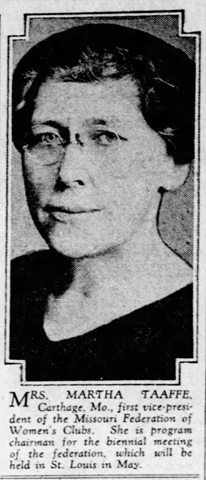Biographical Database of NAWSA Suffragists, 1890-1920
Biography of Martha "Mattie" Coffin Taaffe, 1868-1957
By Katie O'Keefe, student, Drake University, Des Moines, Iowa
Edited by Tammie Busch, Assistant Professor, Southern Illinois University Edwardsville
Martha Coffin was born on March 18, 1868, in St. Louis, Missouri to Tristram Coffin and Mary Degge Coffin. She was the oldest of four siblings: Arthur (1875-19197), Frank (1877-1929), and Little Pearl (1889-1897). The family moved to Carthage, Missouri and she graduated from Carthage High School in 1887 and married Richard Taaffe one week later on June 1, 1887. They had two sons: William Franklin Taaffe and George Richard Taaffe.
Martha was a member of the old Chautauqua Club, an organization focused on innovative programming, engaging events, and scholarships for young women who wanted to change the world. She later joined the Missouri Federation of Women's Club (MFWC) and served in every capacity on the group's board except president. Martha traveled around the state for the MFWC promoting and organizing local clubs. This work was highlighted in a 1915 issue of the suffrage magazine "The Missouri Woman."
According to a biography of Martha published in volume 2 of Show-Me Missouri Women, Martha joined the Cosmos Club a "private social club for men and women distinguished in science, literature and the arts, a learned profession or public service" in 1907. As a member, she helped organize a Woman's Civic League and served on its by-laws committee. She also helped organize a Junior Cosmos Club in 1935.
Martha had strong feelings about women's rights and was not afraid to express them as witnessed by the many reports of her speeches over the years. However, she also put pen to paper as evidenced by an article titled "Women in War" published in the Plattsburg Leader on September 11, 1914, in which Martha states "Armed peace has failed. The utmost efforts of the pacifists have come to naught, and men are saying and writing that only democracy will cure war. And this is true. But it must be a real democracy, where women have full and equal share in the councils which make for war or peace."
As reported by the Carthage Evening Press, Martha met Franklin D. Roosevelt as the vice-presidential candidate when she was a delegate at the 1920 Democratic National Convention in San Francisco. She met Roosevelt again later as President while attending teas at the White House, hosted by Mrs. Roosevelt, as a member of the Conference on the Cause and Cure of War.
According to "The Peculiar History of Women's Suffrage in Jasper County Missouri," the suffrage movement in Jasper County was very progressive, and citizens were not afraid to make their support for the movement known in letters, newspapers, and public events. Martha, along with other prominent suffragists of this region including Emily Newell Blair, played key roles in the movement. Martha was influential in creating the Carthage Suffrage League in 1914 and served on the board of the Missouri Suffrage League.
Once women had gained the right to vote, Martha's work did not slow down. In fact, after the passage of the Nineteenth Amendment, her work, including news of her speeches, is featured more prominently in Missouri newspapers. At a dinner in March of 1921 sponsored by the League of Women Voters, Martha, along with former congressperson Jeannette Rankin and prominent suffragist Edna Fischel Gelhorn, urged women to continue their political activity. Martha also became more involved in politics and strategy for the state Democratic Party including serving as a vice chair of the Jasper County Democratic Committee and as chair of the Women's Democratic Club. In 1926, Martha was nominated by the Democratic Party to run for the Missouri House of Representatives against another woman, Republican Emma Knell. Martha lost the vote by a count of 168 to 154.
After her loss, reports of Martha's work in the MFWC began to pick up again in Missouri newspapers. She was elected second vice president in May 1929 and later served as first vice president. Martha also served as chair of the MFWC biennial meeting held in St. Louis in May 1933. The meeting, as well as Martha's work in her position as chair, was featured prominently in Missouri newspapers. As historian of the MFWC, Martha wrote "History of the Missouri Federation of Women's Clubs, 1896-1946" published in 1946.
In September of 1950, the Joplin Globe reported that Martha had been released from the hospital after a seven-day stay. After that, news of Martha's activity drops significantly until the Carthage Evening Press published her extended obituary on September 11, 1957. Martha is buried in Park Cemetery in Carthage, Missouri.
Sources:
Martha's work is featured prominently in Missouri newspapers. In 1993, the American Association of University Women published a biographical sketch of Martha by Eleanor Coffield in the book Show Me Missouri Women: Selected Biographies, Volume 2 edited by Mary K. Dains and Sue Sadler. In 2014 Mark A. Van Es included the work of Martha in his master's thesis, "The Peculiar History of Women's Suffrage in Jasper County Missouri," freely available at https://digitalcommons.pittstate.edu/etd/119/

Source: St. Louis Post-Dispatch, January 22, 1933

Source: St. Louis Globe-Democrat, April 16, 1933
